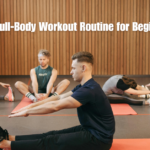Table of Contents
Imagine you have been exercising almost too regularly, lifting weights and following workout plans. The scale does not budge even after you exercise, and strength gains hit the ceiling. This is not training intelligence; it is compound exercises.
That’s how you build muscle, lose fat, and get stronger; you don’t need to spend hours in the gym. Compound exercises are a sure shortcut and fast enough to get a more substantial, capable body.

Weightlifting is an area where both beginners and veterans are included, and compound exercises fall under such exercises. Simple yet most effective examples of such exercises are squats and deadlifts, which involve multiple muscle groups at the same takeoff point.
Compound exercises have evidence to support them. Evidence suggests that they promote testosterone and growth hormone levels, which encourage muscle development. Spending 30 minutes performing compound exercises is more beneficial than spending hours training each muscle group alone.
Key Takeaways
- The compound exercises will help build strength and muscle at a faster rate as compared with isolation moves.
- When done in a full-body workout, these compound exercises save time and target a variety of muscle groups at once.
- Squats and deadlifts cause similar natural hormonal responses that accelerate muscle growth.
- These moves are essential for breaking plateaus and achieving balanced strength.
- Mastering the best compound exercises forms the foundation of any effective fitness routine.
Understanding Compound Exercises and Their Full-Body Benefits
Major movements form the foundation of strength training. They train multiple muscles at once. Squats and deadlifts are compound-movement exercises that increase strength and develop coordination.
What Makes an Exercise “Compound”?
A compound exercise utilizes more than one joint at a time. Push-ups, for instance, work the chest, shoulders, and core with synergy, meaning every repetition engages the entire body. The key examples are:
- Squats (hips, knees, ankles)
- Deadlifts (hips, spine, shoulders)
- Bench presses (shoulders, elbows, wrists)
The Science Behind Compound Movements for Muscle Growth
Compound exercises promote the natural release of growth hormone and testosterone, both of which enable the body to repair and build muscle. Research shows that these are better than isolation lifts for muscle construction.
Efficiency Benefits: Why Compound Exercises Deliver More Results in Less Time
Compound exercises save time and give better results. Here’s how:
- Full-body engagement burns calories faster
- Improved neural efficiency from complex movement patterns
- Strength gains transfer to daily activities
Compared to isolation work, compound lifts let you train smarter—not harder.
Hormonal Advantages of Multi-Joint Movements
Compound exercises trigger hormonal peaks that will support long-term muscle growth. Research shows that heavy lifts like deadlifts increase testosterone by as much as 40% during the workout. This hormonal environment sets your body to build muscle even after the workout.
The 7 Most Effective Compound Exercises for Strength and Muscle Gain
Learning the right top compound exercises can speed up your progress. Here’s how to do each exercise safely and effectively for the best results:
Barbell Squats: The King of Lower Body Development

Barbell squats target the quadriceps, glutes, and hamstrings. Keep your chest out and your knees over your toes. Do not lean forward too much, as this could damage your back. These are very important lower-body power and muscle-building exercises.
Deadlifts: Unleashing Total-Body Power
Deadlifts work your hamstrings, glutes, and lower back. Begin with the hips back, chest up, and a neutral spine. Hinge at the hips while keeping the back straight. Deadlifts are a staple for full-body strength.
Bench Press: Building Upper Body Strength and Muscle
Slightly arch your back and squeeze your shoulder blades together. Bring the bar down toward your chest and press it back up with speed, keeping your elbows from collapsing in. This exercise develops upper body strength and enhances pressing power.
Pull-Ups/Chin-Ups: The Ultimate Back and Bicep Builders
Pull-ups target your biceps more, while chin-ups work your back muscles more. Be sure to contract your abdominals as you strive to lift your chest to meet the bar. Both are crucial for your enhanced back.
Overhead Press: Developing Shoulder Strength and Stability
Push a barbell from shoulder height to a complete lockout. Keeping your core braced and your elbows in front, the exercise trains your shoulders and offers core stability to prevent injuries.
Barbell Rows: Creating a Strong, Defined Back
From the hip joint, bend to bring the bar down towards the lower chest. Keep a flat back, which is ideally suited for targeting the lats and traps. This exercise will help your posture and build thickness in your upper back.
Lunges: The Functional Lower Body Powerhouse
Lunge forward with a step until both knees are at 90 degrees. Concentrate on balance and control. This unilateral exercise builds stability and corrects strength imbalances in your legs.
How to Program Compound Exercises for Maximum Full-Body Results
This isn’t all about bodybuilding. You may need to organize your training for the best results. Try two or three small workouts each week that include squats and deadlift exercises. Make sure to add weight or reps occasionally.

Beginners are recommended to do 3 workouts per week. Each exercise should have 3-4 sets comprising 8-12 repetitions. Intermediate lifters can increase volume when they hit 4 days a week on the entry-level with 4-5 sets. For advanced trainees, the focus is on intensity: 1-3 heavy sets of 3-5 reps.
Sample routines:
Beginner Template:
- Barbell squats: 3×8-12 reps
- Deadlifts: 3×6-8 reps
- Bench press: 3×8-10 reps
- Overhead press: 3×8-10 reps
Intermediate Split:
- Day 1: Squats (4×6-8), Deadlifts (4×5-6)
- Day 2: Bench press (4×6-8), Pull-ups (3×8-10)
Advanced Setup:
- Heavy squats: 5×3-5 reps
- Deadlift max effort: 3×1-3 reps
Keep track of your workout with weights and reps, and change your routine once you hit the plateau. Give yourself 48-hour rest between muscle groups, and get a good sleep. Eat healthy for muscles.
Conclusion: Transform Your Physique with Strategic Compound Training
Compound Movement Exercises are very important when considering strength training approaches. The seven movements described here are sufficient for a total-body workout program with fewer exercises, which saves time and works more muscles.
You should begin sipping on good form and not heavy weights. First, learn bodyweight exercises and then add weights. You can use your dumbbells or bands at home and get gym-like results.
Alter your workout according to your fitness level; beginners perform higher repetitions for muscle control, while you do some heavy lifting for advanced lifters.
Compound lifts work for elite athletes and fitness pros. To prevent injury, adjust for limited equipment and ability with assisted pull-ups to beginner or restricted ranges.
Do these exercises 2 to 3 times a week for steady progress.
Don’t hesitate to incorporate these exercises into your regime. Start with squats, deadlifts, and presses for a total-body workout. Track your lifts to understand how you are progressing. Always safety first and perfect your technique before adding more weight.
Add on musculature, performance improvements, or functional strength gain; these exercises can do more good than harm. They are tested and proven effective, adaptable, and economical to implement. Start right away, and your strength, endurance, and confidence will grow.
FAQ
What are compound exercises?
Compound exercises engage multiple muscles in one repetitive movement. Squatting, deadlifting, and bench pressing are examples of these compound movements. They are essential to a total workout.
Why should I include compound exercises in my workout routine?
First, they dramatically improve muscle growth and strength; they utilize more muscle fibers, which contributes to good muscle gain.
What are the benefits of compound exercises for muscle gain?
They’re another way to develop muscles because they work for a large muscle group and ramp up the effort and calories burned during workout sessions. Besides, they help develop positive links between coordination and athletic performance; therefore, a person gains strength comparatively faster.
How often should I perform compound exercises for optimal results?
For optimum results, exercise 2-3 times a week. You shouldn’t exercise the whole week, but allow your body to rest and the muscles to recover.
Can beginners perform compound exercises?
Of course, a beginner can practice them. The most vital thing is to maintain the correct form to prevent injuries and begin with light-to-normal body weight.
What are some tips for proper form in compound exercises?
Keep the spine straight, control movements, and do not exceed joint limits. It is advisable for beginners to see a trainer.
How do I progress in my compound exercises over time?
Increase weight, add more repetitions, or increase intensity. Monitoring the progression encourages the continued challenge necessary for growth within muscles.
Are compound movements effective for building overall strength?
Yes, those who love compound exercises for building strength love them. Because they work many muscles at a time, they enhance overall body strength. These are suitable for full-body exercises.
Can I perform compound exercises at home?
Definitely, you’re performing squats, lunges, and push-ups at home. Get dumbbells or bands, or even use your body weight for more effective workouts.




